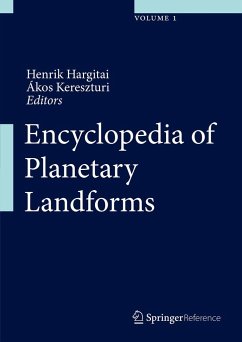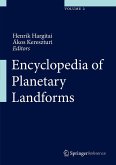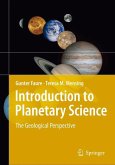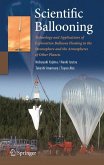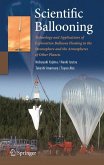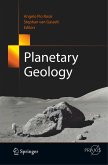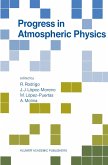This encyclopedia provides a snapshot of our current geological knowledge on solid-surface Solar System bodies. Each entry contains information about the features' morphology, its interpretation, proposed formation models, distribution and occurrence, planetary or terrestrial analogs, and research history. The entries are fully referenced. All image captions include original image IDs.
More than 600 named planetary feature types are discussed in the encyclopedia, covering a wide range of scales--from micrometers to global scale--and also include landform types (structural or topographic features), parts of landforms, terrain types or surface textures, surface patterns, and features identified at wavelengths extending from visible to radio waves (e.g., albedo, thermal infrared, and radar features). The book covers features formed by impact, aeolian, magmatic, volcanic, tectonic, fluvial, lacustrine, marine and coastal, mass movement, sedimentary, desiccation, liquefaction, periglacial, glacial, nival, sublimation, collapse, weathering, and selective erosion or other, including complex processes.
Depending on the information and formation models available, the entries have different approaches. Some of them discuss their subject from the point of view of the inferred process or origin, others are morphology or description-based. As a default, entries focus on extraterrestrial landforms, while also mentioning their proposed terrestrial analogs. Most planetary landforms are not body-specific, but some have no known terrestrial counterparts. Named historic (obsolete) landform types are also included to provide reference for previous key research papers.
To make it easier to find features with related origins, the encyclopedia contains entries that list landforms based on their formative processes. It also lists body-specific features on Mercury (5 feature types), Venus (40), the Earth (13), the Moon (15), Mars (87), Io (7), Europa (17), Callisto (7), Titan (9), Triton (2), mid-sized satellites (8), and small bodies (3). Also included are entries on the 51 planetary feature descriptor terms approved by IAU.
More than 600 named planetary feature types are discussed in the encyclopedia, covering a wide range of scales--from micrometers to global scale--and also include landform types (structural or topographic features), parts of landforms, terrain types or surface textures, surface patterns, and features identified at wavelengths extending from visible to radio waves (e.g., albedo, thermal infrared, and radar features). The book covers features formed by impact, aeolian, magmatic, volcanic, tectonic, fluvial, lacustrine, marine and coastal, mass movement, sedimentary, desiccation, liquefaction, periglacial, glacial, nival, sublimation, collapse, weathering, and selective erosion or other, including complex processes.
Depending on the information and formation models available, the entries have different approaches. Some of them discuss their subject from the point of view of the inferred process or origin, others are morphology or description-based. As a default, entries focus on extraterrestrial landforms, while also mentioning their proposed terrestrial analogs. Most planetary landforms are not body-specific, but some have no known terrestrial counterparts. Named historic (obsolete) landform types are also included to provide reference for previous key research papers.
To make it easier to find features with related origins, the encyclopedia contains entries that list landforms based on their formative processes. It also lists body-specific features on Mercury (5 feature types), Venus (40), the Earth (13), the Moon (15), Mars (87), Io (7), Europa (17), Callisto (7), Titan (9), Triton (2), mid-sized satellites (8), and small bodies (3). Also included are entries on the 51 planetary feature descriptor terms approved by IAU.

